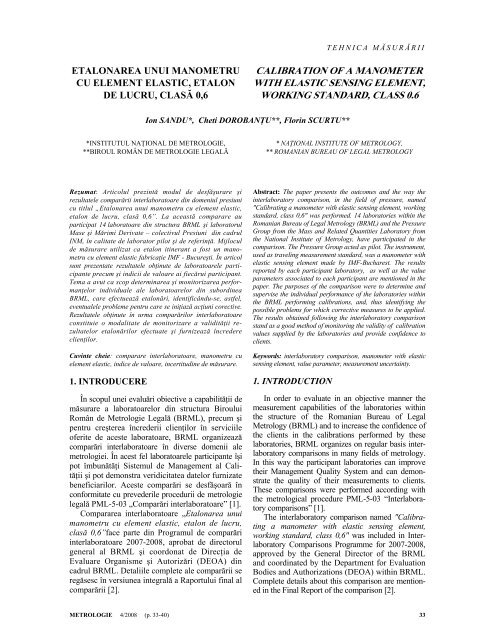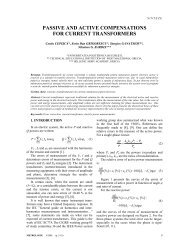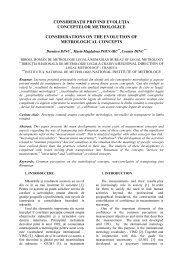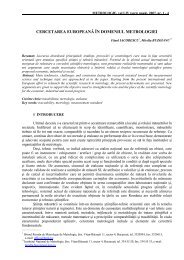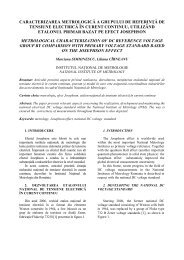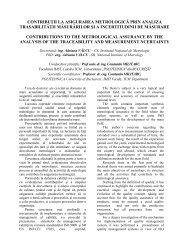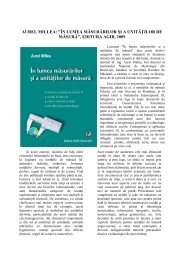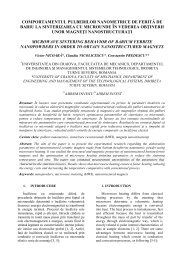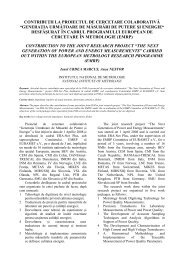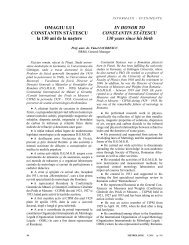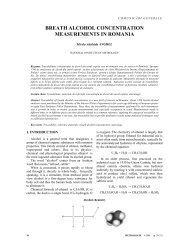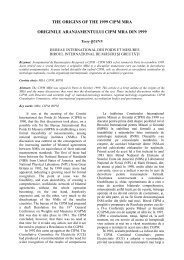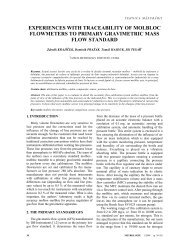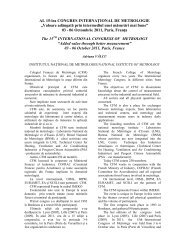Ion Sandu, Cheti Dorobantu, Florin Scurtu, Etalonarea unui ...
Ion Sandu, Cheti Dorobantu, Florin Scurtu, Etalonarea unui ...
Ion Sandu, Cheti Dorobantu, Florin Scurtu, Etalonarea unui ...
You also want an ePaper? Increase the reach of your titles
YUMPU automatically turns print PDFs into web optimized ePapers that Google loves.
TEHNICA MĂ SURĂ RII<br />
ETALONAREA UNUI MANOMETRU<br />
CU ELEMENT ELASTIC, ETALON<br />
DE LUCRU, CLASĂ 0,6<br />
CALIBRATION OF A MANOMETER<br />
WITH ELASTIC SENSING ELEMENT,<br />
WORKING STANDARD, CLASS 0.6<br />
<strong>Ion</strong> SANDU*, <strong>Cheti</strong> DOROBANŢU**, <strong>Florin</strong> SCURTU**<br />
*INSTITUTUL NAŢIONAL DE METROLOGIE,<br />
**BIROUL ROMÂN DE METROLOGIE LEGALĂ<br />
* NAŢIONAL INSTITUTE OF METROLOGY,<br />
** ROMANIAN BUREAU OF LEGAL METROLOGY<br />
Rezumat: Articolul prezintă modul de desfăşurare şi<br />
rezultatele comparării interlaboratoare din domeniul presiuni<br />
cu titlul „<strong>Etalonarea</strong> <strong>unui</strong> manometru cu element elastic,<br />
etalon de lucru, clasă 0,6”. La această comparare au<br />
participat 14 laboratoare din structura BRML şi laboratorul<br />
Mase şi Mărimi Derivate – colectivul Presiuni din cadrul<br />
INM, în calitate de laborator pilot şi de referinţă. Mijlocul<br />
de măsurare utilizat ca etalon itinerant a fost un manometru<br />
cu element elastic fabricaţie IMF - Bucureşti. În articol<br />
sunt prezentate rezultatele obţinute de laboratoarele participante<br />
precum şi indicii de valoare ai fiecărui participant.<br />
Tema a avut ca scop determinarea şi monitorizarea performanţelor<br />
individuale ale laboratoarelor din subordinea<br />
BRML, care efectuează etalonări, identificându-se, astfel,<br />
eventualele probleme pentru care se iniţiază acţiuni corective.<br />
Rezultatele obţinute în urma comparărilor interlaboratoare<br />
constituie o modalitate de monitorizare a validităţii rezultatelor<br />
etalonărilor efectuate şi furnizează încredere<br />
clienţilor.<br />
Cuvinte cheie: comparare interlaboratoare, manometru cu<br />
element elastic, indice de valoare, incertitudine de măsurare.<br />
1. INTRODUCERE<br />
În scopul unei evaluări obiective a capabilităţii de<br />
măsurare a laboratoarelor din structura Biroului<br />
Român de Metrologie Legală (BRML), precum şi<br />
pentru creşterea încrederii clienţilor în serviciile<br />
oferite de aceste laboratoare, BRML organizează<br />
comparări interlaboratoare în diverse domenii ale<br />
metrologiei. În acest fel laboratoarele participante îşi<br />
pot îmbunătăţi Sistemul de Management al Calităţii<br />
şi pot demonstra veridicitatea datelor furnizate<br />
beneficiarilor. Aceste comparări se desfăşoară în<br />
conformitate cu prevederile procedurii de metrologie<br />
legală PML-5-03 „Comparări interlaboratoare” [1].<br />
Compararea interlaboratoare „<strong>Etalonarea</strong> <strong>unui</strong><br />
manometru cu element elastic, etalon de lucru,<br />
clasă 0,6”face parte din Programul de comparări<br />
interlaboratoare 2007-2008, aprobat de directorul<br />
general al BRML şi coordonat de Direcţia de<br />
Evaluare Organisme şi Autorizări (DEOA) din<br />
cadrul BRML. Detaliile complete ale comparării se<br />
regăsesc în versiunea integrală a Raportului final al<br />
comparării [2].<br />
Abstract: The paper presents the outcomes and the way the<br />
interlaboratory comparison, in the field of pressure, named<br />
"Calibrating a manometer with elastic sensing element, working<br />
standard, class 0,6" was performed. 14 laboratories within the<br />
Romanian Bureau of Legal Metrology (BRML) and the Pressure<br />
Group from the Mass and Related Quantities Laboratory from<br />
the National Institute of Metrology, have participated in the<br />
comparison. The Pressure Group acted as pilot. The instrument,<br />
used as traveling measurement standard, was a manometer with<br />
elastic sensing element made by IMF-Bucharest. The results<br />
reported by each participant laboratory, as well as the value<br />
parameters associated to each participant are mentioned in the<br />
paper. The purposes of the comparison were to determine and<br />
supervise the individual performance of the laboratories within<br />
the BRML performing calibrations, and, thus identifying the<br />
possible problems for which corrective measures to be applied.<br />
The results obtained following the interlaboratory comparison<br />
stand as a good method of monitoring the validity of calibration<br />
values supplied by the laboratories and provide confidence to<br />
clients.<br />
Keywords: interlaboratory comparison, manometer with elastic<br />
sensing element, value parameter, measurement uncertainty.<br />
1. INTRODUCTION<br />
In order to evaluate in an objective manner the<br />
measurement capabilities of the laboratories within<br />
the structure of the Romanian Bureau of Legal<br />
Metrology (BRML) and to increase the confidence of<br />
the clients in the calibrations performed by these<br />
laboratories, BRML organizes on regular basis interlaboratory<br />
comparisons in many fields of metrology.<br />
In this way the participant laboratories can improve<br />
their Management Quality System and can demonstrate<br />
the quality of their measurements to clients.<br />
These comparisons were performed according with<br />
the metrological procedure PML-5-03 “Interlaboratory<br />
comparisons” [1].<br />
The interlaboratory comparison named "Calibrating<br />
a manometer with elastic sensing element,<br />
working standard, class 0,6" was included in Interlaboratory<br />
Comparisons Programme for 2007-2008,<br />
approved by the General Director of the BRML<br />
and coordinated by the Department for Evaluation<br />
Bodies and Authorizations (DEOA) within BRML.<br />
Complete details about this comparison are mentioned<br />
in the Final Report of the comparison [2].<br />
METROLOGIE 4/2008 (p. 33-40) 33
Virginia MATEI, Gabriel VLADUT, Aurel MOGOSAN, Henk BLAAUW, Bert de VRIES, Petra SEIWERTH, Alexander KAMPFER<br />
2. ORGANIZAREA COMPARĂRII<br />
În perioada 05.2007 - 11.2008, în cadrul domeniului<br />
Mecanice, subdomeniul Presiuni, s-a<br />
desfăşurat tema de comparare interlaboratoare cu<br />
titlul “<strong>Etalonarea</strong> <strong>unui</strong> manometru cu element<br />
elastic, etalon de lucru, clasă 0,6”. La această temă<br />
au participat 14 locaţii din cadrul Laboratoarelor<br />
regionale din structura Biroului Român de Metrologie<br />
Legală după cum urmează: Piatra Neamţ,<br />
Suceava, Sibiu, Miercurea Ciuc, Craiova, Slatina,<br />
Râmnicu Vâlcea, Drobeta Turnu Severin, Târgu<br />
Jiu, Arad, Baia Mare, Satu Mare, Zalău şi Bistriţa.<br />
Colectivul Presiuni din cadrul Institutul Naţional<br />
de Metrologie a fost desemnat laborator pilot şi<br />
laborator de referinţă. Ca etalon itinerant a fost<br />
utilizat un manometru cu element elastic, fabricaţie<br />
IMF – Bucureşti cu următoarele caracteristici<br />
tehnice şi metrologice:<br />
– domeniul de măsurare: (0…6) bar;<br />
– clasa de exactitate: 0,6;<br />
– tipul indicaţiei: analogică;<br />
– seria: 42117;<br />
– anul fabricaţiei: 1981;<br />
– diametrul carcasei: Φ160 mm;<br />
– racordul de presiune: M20×1,5;<br />
– mediul de lucru: ulei.<br />
Laboratoarele participante au fost organizate în<br />
două grupe, fiecare laborator primind din partea<br />
DEOA, un număr de cod cu care va fi menţionat în<br />
continuare în acest articol. Laboratorul pilot şi de<br />
referinţă a primit codul 1.<br />
Măsurările asupra etalonului itinerant au fost<br />
efectuate de laboratoarele participante, într-o comparare<br />
de tip circular. Schema de circulaţie a<br />
etalonului itinerant este prezentată în Figurile 1 şi 2.<br />
2. THE ORGANIZATION<br />
OF THE COMPARISON<br />
During 05.2007 - 11.2008, in the Mechanics<br />
field, Pressure subfield, it was performed an interlaboratory<br />
comparison named “Calibration of a<br />
manometer with elastic sensing element, working<br />
standard, class 0.6”. 14 regional laboratories within<br />
BRML have participated in this comparison, as<br />
follows: Piatra Neamţ, Suceava, Sibiu, Miercurea<br />
Ciuc, Craiova, Slatina, Râmnicu Vâlcea, Drobeta<br />
Turnu Severin, Târgu Jiu, Arad, Baia Mare, Satu<br />
Mare, Zalău and Bistriţa. The Pressure laboratory<br />
from National Institute of Metrology was designated<br />
as pilot laboratory and reference laboratory. The<br />
traveling measurement standard was a manometer<br />
with elastic sensing element, made by IMF –<br />
Bucharest, with the following technical and metrological<br />
characteristics:<br />
– measurement range: (0…6) bar;<br />
– accuracy class: 0.6;<br />
– type of indication: analogic;<br />
– serial number: 42117;<br />
– year of fabrication: 1981;<br />
– diameter of the case: Φ 160 mm<br />
– connecting pressure: M20×1.5;<br />
– working fluid: oil.<br />
The participant laboratories were organised in<br />
two groups, each laboratory receiving from the<br />
DEOA a code number mentioned in this paper.<br />
The pilot and reference laboratory was given cod<br />
number 1.<br />
In each participant laboratory, the measurements,<br />
were performed in accordance with a circular<br />
scheme. The scheme for the circulation of the traveling<br />
measurement standard is shown in the Figures 1<br />
and 2.<br />
Locaţia<br />
Arad<br />
INM<br />
Colectiv<br />
Presiuni<br />
Locaţia<br />
Satu Mare<br />
INM<br />
Colectiv<br />
Presiuni<br />
Locaţia<br />
Miercurea<br />
Ciuc<br />
Locaţia<br />
Craiova<br />
Locaţia<br />
Baia Mare<br />
Locaţia<br />
Piatra<br />
Neamţ<br />
Locaţia<br />
Sibiu<br />
Locaţia<br />
Tg. Jiu<br />
Locaţia<br />
Dr.Tr.<br />
Severin<br />
Locaţia<br />
Rm.<br />
Vâlcea<br />
Locaţia<br />
Slatina<br />
Locaţia<br />
Zalău<br />
Locaţia<br />
Bistriţa<br />
Locaţia<br />
Suceava<br />
Fig. 1. Schema de circulaţie a etalonului itinerant – prima grupă.<br />
Fig. 2. Schema de circulaţie a etalonului itinerant – a doua grupă.<br />
34<br />
METROLOGIE 4/2008
ETALONAREA UNUI MANOMETRU CU ELEMENT ELASTIC, ETALON DE LUCRU, CLASĂ 0,6<br />
3. VALORI DE REFERINŢĂ<br />
Valorile de referinţă sunt valorile indicaţiei etalonului<br />
itinerant, rezultate la compararea indicaţiilor<br />
etalonului itinerant cu un manometru cu piston şi<br />
greutăţi de exactitate ridicată.<br />
Valorile de referinţă finale, atribuite etalonului<br />
itinerant, reprezintă media a trei valori obţinute din<br />
etalonarea acestuia, în cadrul laboratorului de referinţă,<br />
la începutul, la mijlocul şi la finalul comparării.<br />
Valorile de referinţă finale, erorile de măsurare<br />
ale laboratorului de referinţă şi incertitudinea de<br />
măsurare asociată valorilor de referinţă sunt prezentate<br />
în tabelul 1.<br />
4. PROCEDURI ŞI MIJLOACE DE<br />
MĂSURARE<br />
Conform instrucţiunilor de măsurare elaborate<br />
de laboratorul pilot, pentru efectuarea măsurărilor a<br />
fost utilizată norma tehnică de metrologie NTM 3 –<br />
130 – 94 “Verificarea metrologică a manometrelor<br />
şi vacuummetrelor etalon cu element elastic” [2].<br />
Metoda de măsurare utilizată a fost metoda<br />
comparării directe a indicaţiilor corespunzătoare<br />
etalonului itinerant cu indicaţiile <strong>unui</strong> manometru<br />
cu element elastic (Lab.14) de exactitate superioară,<br />
sau cu valorile reproduse de manometre cu<br />
piston şi greutăţi (restul laboratoarelor participante).<br />
Rezultatele măsurărilor efectuate asupra etalonului<br />
itinerant au fost consemnate de laboratoarele<br />
participante în fişele de date primare transmise<br />
laboratorului pilot împreună cu fişele de calcul a<br />
incertitudinii de măsurare şi Certificatul de Etalonare<br />
al etalonului itinerant.<br />
La predarea şi la primirea etalonului itinerant,<br />
fiecare laborator participant a întocmit un proces<br />
verbal de predare/primire în care a menţionat starea<br />
etalonului itinerant la primire, respectiv predare.<br />
3. REFERENCE VALUES<br />
The reference values are the indicated values of<br />
the traveling measurement standard, as a result of<br />
the comparison of its indications with the values<br />
reproduced by a piston gauge with high accuracy.<br />
The final reference values, associated with the<br />
traveling measurement standard, are the mean<br />
values of the indicated values (measurements were<br />
performed in INM-Pressure laboratory) at the<br />
beginning, middle and the end of the comparison.<br />
The final reference values, measurements errors<br />
and the associated uncertainties of the reference<br />
values are presented in Table 1.<br />
4. PROCEDURES MEASUREMENT<br />
AND STANDARDS<br />
In accordance with the Measurement Instructions,<br />
elaborated by the pilot laboratory, the<br />
metrological norm NTM 3-130-94 “Metrological<br />
verification of the manometers and vacuummeters<br />
with elastic sensing element” [2], was used to<br />
perform the measurements. The measurement<br />
method used was the direct comparison of the<br />
indicated values of the traveling measurement<br />
standard with the indicated values of a manometer<br />
with elastic sensing element, having a better<br />
uncertainty in the case of Lab.14, or with the<br />
reproduced values by the piston gauges (in the case<br />
of all other participant laboratories).<br />
Measurement results performed by the laboratories,<br />
on the traveling measurement standard, were<br />
recorded and sent to the pilot laboratory, together<br />
with the measurement uncertainty calculation and<br />
Calibration Certificate for the traveling measurement<br />
standard, respectively.<br />
At the delivering/receiving of the traveling<br />
measurement standard, a minute was issued between<br />
the laboratories, describing the state of measurement.<br />
Tabelul 1 / Table 1<br />
Valori de referinţă, erori de măsurare şi incertitudinea de măsurare asociată<br />
valorilor de referinţă<br />
Final reference values, measurements errors and associated uncertainties<br />
of the reference values<br />
Presiune nominală<br />
Nominal pressure<br />
[bar] 0,000 1,000 2,000 2,500 3,000 3,500 4,000 5,000 6,000<br />
Valori de referinţă<br />
Reference values<br />
[bar] 0,020 0,999 2,000 2,508 3,015 3,518 4,018 5,009 6,002<br />
Erori de măsurare<br />
Measurements errors<br />
[bar] +0,020 -0,001 0,000 +0,008 +0,015 +0,018 +0,018 +0,009 +0,002<br />
U(k = 2) [bar] 0,011<br />
METROLOGIE 4/2008 35
<strong>Ion</strong> SANDU, <strong>Cheti</strong> DOROBANŢU, <strong>Florin</strong> SCURTU<br />
5. REZULTATELE MĂSURĂRILOR<br />
Fiecare laborator participant a efectuat măsurările<br />
în 9 puncte de presiune distribuite uniform<br />
pe domeniul de măsurare al etalonului itinerant,<br />
incluzându-se limita minimă şi limita maximă.<br />
Aceste puncte au fost următoarele: 0 bar; 1 bar;<br />
2 bar; 2,5 bar; 3 bar; 3,5 bar; 4 bar; 5 bar; 6 bar;<br />
Fiecare laborator a avut libertatea de a alege<br />
modul propriu de efectuare al măsurărilor, adecvat<br />
etalonării. Măsurările s-au efectuat astfel:<br />
– trei cicluri de măsurări, cu presiuni în creştere şi<br />
cu presiuni în descreştere, cu menţinerea aparatului la<br />
presiunea maximă, timp de 5 minute, pentru a pune<br />
în evidenţă histerezisul (Lab.2, Lab.5, Lab.8, Lab.9,<br />
Lab.10, Lab.11, Lab.12, Lab.13, Lab.15);<br />
– trei cicluri de măsurări, cu presiuni în creştere<br />
şi cu presiuni în descreştere, cu citirea indicaţiilor<br />
înainte şi după ciocănirea carcasei cu degetul şi<br />
menţinerea aparatului la presiunea maximă, timp<br />
de 5 minute, pentru a pune în evidenţă histerezisul<br />
(Lab.3 şi Lab.14);<br />
– două cicluri de măsurări, cu presiuni în<br />
creştere şi cu presiuni în descreştere, cu citirea<br />
indicaţiilor înainte şi după ciocănirea carcasei cu<br />
degetul şi menţinerea aparatului la presiunea<br />
maximă, timp de 5 minute, pentru a pune în evidenţă<br />
histerezisul (Lab.6);<br />
– două cicluri de măsurări, cu presiuni în creştere<br />
şi cu presiuni în descreştere, pentru toate punctele de<br />
presiune şi cu un al treilea ciclu de măsurare la o<br />
presiune de la mijlocul intervalului de măsurare,<br />
pentru determinarea repetabilităţii (Lab.4).<br />
Rezultatele măsurărilor obţinute de cele 14 laboratoare<br />
participante (valorile medii de presiune),<br />
incertitudinile asociate acestor rezultate, erorile de<br />
măsurare, precum şi diferenţele între rezultatele<br />
măsurărilor efectuate de laboratoarele participante<br />
şi valorile de referinţă obţinute de laboratorul pilot<br />
sunt prezentate în Tabelele 2, 3 şi 4. Lab.2 şi Lab.9<br />
nu au precizat în certificatul de etalonare al etalonului<br />
itinerant rezultatele obţinute pentru punctele<br />
de presiune de 0 bar, respectiv 0 bar şi 6 bar. Pentru<br />
cele două puncte de presiune nu au putut fi calculate<br />
nici erorile intrinseci, nici diferenţele între valorile<br />
de referinţă şi valorile medii de presiune.<br />
Prezentarea grafică a acestor rezultate se regăseşte<br />
în Raportul final al comparării interlaboratoare<br />
[2], Figurile 1÷13. Pentru exemplificare se prezintă<br />
mai jos erorile intrinseci şi incertitudinile de măsurare<br />
asociate valorilor medii de presiune, pentru<br />
punctul de presiune de 2 bar (figura 3).<br />
Notă: Eroarea maxim tolerată a etalonului itinerant<br />
s-a calculat cu formula:<br />
Er<br />
maxtol<br />
Interval de masurare × Clasa de exactitate<br />
= [bar]<br />
100<br />
(1)<br />
5. RESULTS<br />
Each participant laboratory performed the measurements<br />
in 9 points of pressure equal distributed<br />
within the range of the traveling measurement<br />
standard, including the minimum and maximum<br />
values. The points of pressure were as following:<br />
0 bar; 1 bar; 2 bar; 2.5 bar; 3 bar; 3.5 bar; 4 bar; 5<br />
bar and 6 bar.<br />
Each participant laboratory had the possibility<br />
to choose the way to perform the measurements.<br />
The measurements were performed as follows:<br />
– three cycles of measurements, with increasing<br />
pressures and then decreasing pressures at the maximum<br />
value the pressure maintained for 5 minutes,<br />
in order to put into evidence the hysteresis (Lab.2,<br />
Lab.5, Lab.8, Lab.9, Lab.10, Lab.11, Lab.12,<br />
Lab.13, Lab.15)<br />
– three cycles of measurements, with increasing<br />
pressures and then decreasing pressures. at each<br />
pressure the indications were recorded before and<br />
after knocking the case of the standard. This<br />
decision was taken in order to put into evidence the<br />
friction. At the maximum value the pressure was<br />
maintained for 5 minutes, in order to put into<br />
evidence the hysteresis (Lab. 6).<br />
– two cycles of measurements, with increasing<br />
pressures and then decreasing pressures. At the<br />
maximum value the pressure was maintained for<br />
5 minutes, in order to put into evidence the hysteresis.<br />
In order to calculate the repeatability, at<br />
the point of the medium range, a third cycle of<br />
measurements was performed (Lab. 4).<br />
Measurements results obtained by the 14 participant<br />
laboratories (mean values), the associated<br />
uncertainties, measurement errors and the differences<br />
between values of the participant laboratories<br />
and the values of the pilot laboratory are shown in<br />
Tables 2, 3 and 4.<br />
The laboratories Lab.2 and Lab.9 have not<br />
mentioned in the Calibration Certificate the results<br />
obtained for 0 bar point pressure respectively for 0<br />
bar and 6 bar points pressure. For these points, the<br />
measurement errors and the differences between<br />
these laboratories and pilot laboratory, were not<br />
calculated.<br />
The graphic presentation of these results are<br />
included in the Final Report of the comparison [2],<br />
Figures 1…13. Just to exemplify in this paper the<br />
measurement errors and associated uncertainties only<br />
for 2 bar point pressure are presented in Figure 3.<br />
Note: Maximum admissible error of the traveling<br />
measurement standard was calculated using the formula:<br />
Er<br />
max<br />
Measurement range × Accuracy class<br />
= [bar]<br />
100<br />
(1)<br />
36<br />
METROLOGIE 4/2008
ETALONAREA UNUI MANOMETRU CU ELEMENT ELASTIC, ETALON DE LUCRU, CLASĂ 0,6<br />
Cod lab.<br />
Lab. code<br />
Tabelul 2 / Table 2<br />
Valorile medii de presiune obţinute de cele 15 laboratoare şi<br />
incertitudinile asociate acestor valori (laboratorul pilot are codul 1)<br />
Pressure mean values obtained by all 15 laboratories and the<br />
associated uncertainties (code number of the pilot laboratory is 1)<br />
Presiunea nominală / Nominal pressure values<br />
[bar]<br />
0,000 1,000 2,000 2,500 3,000 3,500 4,000 5,000 6,000<br />
1 0,020 0,999 2,000 2,508 3,015 3,518 4,018 5,009 6,002 0,011<br />
U(k=2)<br />
[bar]<br />
2 0,010 0,992 1,995 2,501 3,002 3,505 4,003 4,997 - 0,003…0,005<br />
3 0,012 0,992 1,994 2,503 3,008 3,515 4,015 5,010 6,003 0,013…0,015<br />
4 0,000 0,993 1,994 2,497 3,003 3,508 4,007 5,001 5,992 0,012<br />
5 0,000 0,989 1,993 2,498 3,003 3,510 4,013 5,002 6,000 0,006…0,014<br />
6 0,008 0,998 2,000 2,504 3,009 3,510 4,011 5,006 6,006 0,006…0,044<br />
7 0,000 0,994 1,998 2,500 3,011 3,506 4,019 5,011 6,006 0,019<br />
8 0,000 1,001 1,999 2,505 3,006 3,510 4,011 5,008 5,996 0.017<br />
9 - 0,998 1,999 2,503 3,006 3,508 4,008 5,004 - 0,011…0,012<br />
10 0,000 0,897 1,994 2,500 3,006 3,512 4,012 5,006 6,000 0,014<br />
11 0,000 0,990 1,991 2,498 3,004 3,509 4,004 5,002 5,995 0,014…0,021<br />
12 0,015 0,999 1,999 2,500 3,002 3,503 4,001 4,998 5,996 0,007…0,013<br />
13 0,000 0,991 1,994 2,497 3,002 3,505 4,007 5,002 5,997 0,0167<br />
14 0,017 0,998 1,997 2,503 3,011 3,511 4,013 5,010 6,006 0,0151…0,0234<br />
15 0,000 0,990 1,990 2,500 3,000 3,505 4,005 5,000 5,970 0,0288<br />
Cod lab.<br />
Lab. code<br />
Tabelul 3 / Table 3<br />
Erorile (intrinseci) de măsurare pentru laboratorul pilot şi laboratoarele participante<br />
Measurements errors (intrinsic errors) for pilot laboratory and the participant laboratories<br />
Erori de măsurare [bar] obţinute la următoarele valori nominale ale presiunii<br />
Measurement errors [bar] obtained at the following nominal pressure values<br />
[bar]<br />
0,000 1,000 2,000 2,500 3,000 3,500 4,000 5,000 6,000<br />
1 +0,020 -0,001 0,000 +0,008 +0,015 +0,018 +0,018 +0,009 +0,002<br />
2 +0,010 -0,008 -0,005 +0,001 +0,002 +0,005 +0,003 -0,003 -<br />
3 +0,012 -0,008 -0,006 +0,003 +0,008 +0,015 +0,015 +0,010 +0,003<br />
4 0,000 -0,007 -0,006 -0,003 +0,003 +0,008 +0,007 +0,001 -0,008<br />
5 0,000 -0,011 -0,007 -0,002 +0,003 +0,010 +0,013 +0,002 0,000<br />
6 +0,008 -0,002 0,000 +0,004 +0,009 +0,010 +0,011 +0,006 +0,006<br />
7 0,000 -0,006 -0,002 0,000 +0,011 +0,006 +0,019 +0,011 +0,006<br />
8 0,000 +0,001 -0,001 +0,005 +0,006 +0,010 +0,011 +0,008 -0,004<br />
9 - -0,002 -0,001 +0,003 +0,006 +0,008 +0,008 +0,004 -<br />
10 0,000 -0,003 -0,006 0,000 +0,006 +0,012 +0,012 +0,006 0,000<br />
11 0,000 -0,010 -0,009 -0,002 +0,004 +0,009 +0,004 +0,002 -0,005<br />
12 +0,015 -0,001 -0,001 0,000 +0,002 +0,003 +0,001 -0,002 -0,004<br />
13 0,000 -0,009 -0,006 -0,003 +0,002 +0,005 +0,007 +0,002 -0,003<br />
14 +0,017 -0,002 -0,003 +0,003 +0,011 +0,011 +0,013 +0,010 +0,006<br />
15 0,000 -0,010 -0,010 0,000 0,000 +0,005 +0,005 0,000 -0,030<br />
METROLOGIE 4/2008 37
<strong>Ion</strong> SANDU, <strong>Cheti</strong> DOROBANŢU, <strong>Florin</strong> SCURTU<br />
Cod lab.<br />
Lab. code<br />
Tabelul 4 / Table 4<br />
Diferenţele dintre valorile medii obţinute de laboratoarele participante şi laboratorul pilot<br />
Differences between mean values obtained by the participant laboratories and pilot laboratory<br />
Diferenţele valorilor nominale ale presiunii<br />
Measured differences of nominal pressure values<br />
[bar]<br />
0,000 1,000 2,000 2,500 3,000 3,500 4,000 5,000 6,000<br />
2 -0,010 -0,007 -0,005 -0,007 -0,013 -0,013 -0,015 -0,012 -<br />
3 -0,008 -0,007 -0,006 -0,005 -0,007 -0,003 -0,003 +0,001 +0,001<br />
4 -0,020 -0,006 -0,006 -0,011 -0,012 -0,010 -0,011 -0,008 -0,010<br />
5 -0,020 -0,010 -0,007 -0,010 -0,012 -0,008 -0,005 -0,007 -0,002<br />
6 -0,012 -0,001 0 -0,004 -0,006 -0,008 -0,007 -0,003 +0,004<br />
7 -0,020 -0,005 -0,002 -0,008 -0,004 -0,012 +0,001 +0,002 +0,004<br />
8 -0,020 +0,002 -0,001 -0,003 -0,009 -0,008 -0,007 -0,001 -0,006<br />
9 - -0,001 -0,001 -0,005 -0,009 -0,010 -0,010 -0,005 -<br />
10 -0,020 -0,002 -0,006 -0,008 -0,009 -0,006 -0,006 -0,003 -0,002<br />
11 -0,020 -0,009 -0,009 -0,010 -0,011 -0,009 -0,014 -0,007 -0,007<br />
12 -0,005 0 -0,001 -0,008 -0,013 -0,015 -0,017 -0,011 -0,006<br />
13 -0,020 -0,008 -0,006 -0,011 -0,013 -0,013 -0,011 -0,007 -0,005<br />
14 -0,003 -0,001 -0,003 -0,005 -0,004 -0,007 -0,005 +0,001 +0,004<br />
15 -0,020 -0,009 -0,010 -0,008 -0,015 -0,013 -0,013 -0,009 -0,032<br />
Eroarea intrinseca la 2<br />
bar<br />
0,04<br />
0,035<br />
0,03<br />
0,025<br />
0,02<br />
0,015<br />
0,01<br />
0,005<br />
-0,005 0<br />
-0,01<br />
-0,015<br />
-0,02<br />
-0,025<br />
-0,03<br />
-0,035<br />
-0,04<br />
Nr. de cod al laboratorului<br />
Lab. pilot Lab. 2 Lab. 3 Lab. 4 Lab. 5 Lab. 6<br />
Lab. 7 Lab. 8 Lab. 9 Lab. 10 Lab. 11 Lab. 12<br />
Lab. 13 Lab. 14 Lab. 15 Er. Max. + Er. Max. -<br />
Fig. 3. Erorile de măsurare şi incertitudinile asociate pentru punctul de presiune de 2 bar /<br />
Measurement errors and associated uncertainties for point pressure of 2 bar.<br />
6. INDICII DE VALOARE<br />
Pentru fiecare laborator participant, laboratorul<br />
de referinţă a determinat, indicele de valoare E i ,<br />
i = 2…15, exprimat prin relaţia:<br />
E<br />
i<br />
xi<br />
− xref<br />
≡ (2)<br />
U + U<br />
2<br />
i<br />
2<br />
ref<br />
în care: E i este indicele de valoare al laboratorului<br />
„i”; x i – valoarea mărimii corespunzătoare etalonului<br />
6. VALUES OF PARAMETERS<br />
For each participant laboratory a value of parameter<br />
E i , i = 2…15 was calculated using the<br />
formula:<br />
E<br />
i<br />
xi<br />
− xref<br />
≡ (2)<br />
U + U<br />
2<br />
i<br />
2<br />
ref<br />
where: E i is the value of parameter for the „i”<br />
laboratory; x i – value of the traveling measurement<br />
38<br />
METROLOGIE 4/2008
ETALONAREA UNUI MANOMETRU CU ELEMENT ELASTIC, ETALON DE LUCRU, CLASĂ 0,6<br />
itinerant la un punct de etalonare specificat, raportată<br />
de laboratorul „i”; x ref – valoarea etalonului<br />
de transfer la un punct de presiune, obţinută în<br />
laboratorul de referinţă; U i , U ref – incertitudinile<br />
extinse evaluate şi raportate de laboratorul „i” şi<br />
de laboratorul de referinţă; i – codul atribuit<br />
laboratorului participant.<br />
Indicii de valoare ai celor 14 laboratoare<br />
participante sunt prezentaţi în Tabelul 5. Celulele<br />
închise la culoare marchează indicii de valoare<br />
care depăşesc limitele –1,0 şi +1,0.<br />
Prezentarea grafică a acestor rezultate se găseşte<br />
în Raportul final al comparării interlaboratoare [3],<br />
Figurile 14 şi 15.<br />
7. APRECIERI FINALE<br />
Din analiza rezultatelor măsurărilor şi a incertitudinilor<br />
asociate raportate de laboratoarele<br />
participante precum şi a indicilor de valoare<br />
rezultaţi s-au concluzionat următoarele:<br />
• 9 laboratoare (Lab.3, Lab.6, Lab.7, Lab.8,<br />
Lab.9, Lab.11, Lab.13, Lab.14, şi Lab.15) au<br />
obţinut rezultate compatibile cu cele ale laboratorului<br />
pilot şi de referinţă şi satisfac criteriile de<br />
acceptare la toate punctele de etalonare precizate în<br />
certificatele de etalonare transmise.<br />
• 5 laboratoare (Lab.2, Lab.4, Lab.5, Lab.10 şi<br />
Lab.12) au indicii de valoare mai mari decât<br />
limitele admise la unele puncte de presiune (Lab.2<br />
la 3 puncte de presiune şi Lab.4, Lab.5, Lab.10,<br />
Lab.12 la un punct de presiune).<br />
Faţă de comparările precedente, desfăşurate în<br />
perioadele 2003 - 2004 şi 2005 - 2006 s-a constatat<br />
o îmbunătăţire a rezultatelor obţinute, 9 laboratoare<br />
din 14 obţinând rezultate compatibile cu cele ale<br />
laboratorului de referinţă.<br />
standard at one pressure point, obtained by the „i”<br />
laboratory; x ref – value of the traveling measurement<br />
standard at one pressure point, obtained by<br />
the reference laboratory; U i , U ref – expanded<br />
uncertainties obtained by the „i” laboratory and the<br />
reference laboratory; i – code number assigned to<br />
the participant laboratories.<br />
The values of parameter for all participant<br />
laboratories are presented in the Table 5. The grey<br />
cells put into evidence the values of parameter<br />
which exceeded the limits –1.0 and +1.0.<br />
The graphic representation of these results are<br />
in the Final Report of the comparison [2], Figures<br />
14 and 15.<br />
7. CONCLUSIONS<br />
The analysis of the measurement results and the<br />
associated uncertainties of the participant laboratories,<br />
on the first hand and the indices of values,<br />
on the other hand, have conducted to the following<br />
conclusions:<br />
• 9 laboratories (Lab.3, Lab.6, Lab.7, Lab.8,<br />
Lab.9, Lab.11, Lab.13, Lab.14 and Lab.15) have<br />
compatible results with the pilot and reference<br />
pilot and their results are satisfactory and acceptable<br />
at all points specified in the Calibration<br />
Certificates.<br />
• 5 laboratories (Lab.2, Lab.4, Lab.5, Lab.10<br />
and Lab.12) have the values of parameter out of<br />
the maximum limits in some pressure points (Lab.2<br />
in three pressure points and Lab.4, Lab.5, Lab.10,<br />
Lab.12 only in one pressure point).<br />
Comparative to similar comparisons performed<br />
during 2003-2004 and 2005-2006 one can note that<br />
now the results are improved, 9 of 14 laboratories<br />
being compatible with the reference laboratory.<br />
Cod lab.<br />
Lab. code<br />
Tabelul 5 / Table 5<br />
Indicii de valoare obţinuţi de laboratoarele participante<br />
The values of parameter for the participant laboratories<br />
Indicii E i calculaţi pentru următoarele valori ale presiunii nominale<br />
Indices of values E i calculated at the following nominal pressure values<br />
[bar]<br />
0,000 1,000 2,000 2,500 3,000 3,500 4,000 5,000 6,000<br />
2 -0,83 -0,58 -0,42 -0,58 -1,08 -1,08 -1,25 -1,00 -<br />
3 -0,42 -0,37 -0,32 -0,26 -0,37 -0,16 -0,16 +0,05 +0,05<br />
4 -1,20 -0,37 -0,38 -0,69 -0,63 -0,63 -0,69 -0,50 -0,63<br />
5 -1,10 -0,55 -0,39 -0,56 -0,67 -0,44 -0,28 -0,39 -0,11<br />
6 -0,32 -0,03 0 -0,11 -0,16 -0,21 -0,18 -0,08 +0,10<br />
7 -0,91 -0,23 -0,09 -0,36 -0,18 -0,55 +0,05 +0,09 +0,18<br />
8 -1,00 +0,10 -0,05 -0,15 -0,45 -0,40 -0,35 -0,05 -0,30<br />
9 - -0,06 -0,06 -0,31 -0,56 -0,63 -0,63 -0,31 -<br />
10 -1,10 -0,11 -0,33 -0,44 -0,50 -0,33 -0,33 -0,17 -0,11<br />
11 -0,83 -0,37 -0,38 -0,42 -0,46 -0,38 -0,58 -0,29 -0,29<br />
12 -0,30 0 -0,06 -0,50 -0,81 -0,94 -1,06 -0,69 -0,38<br />
13 -1,00 -0,40 -0,30 -0,55 -0,65 -0,65 -0,55 -0,35 -0,25<br />
14 -0,12 -0,04 -0,12 -0,20 -0,16 -0,28 -0,20 +0,04 +0,16<br />
15 -0,64 -0,29 -0,32 -0,32 -0,48 -0,42 -0,42 -0,29 -1,00<br />
METROLOGIE 4/2008 39
<strong>Ion</strong> SANDU, <strong>Cheti</strong> DOROBANŢU, <strong>Florin</strong> SCURTU<br />
BIBLIOGRAFIE<br />
[1] BRML-DEOA, PML-5-03 „Comparări interlaboratoare”.<br />
[2] Colectiv Presiuni-INM, BRML-DEOA – „Raport final al<br />
comparării interlaboratoare”.<br />
[3] NTM 3 – 130 – 94 “Verificarea metrologică a manometrelor<br />
şi vacuummetrelor etalon cu element elastic”.<br />
REFERENCES<br />
[1] BRML - DEOA, PML-5-03 “Comparări interlaboratoare”.<br />
[2] Colectiv Presiuni - INM, BRML - DEOA „Raport final al<br />
comparării interlaboratoare”.<br />
[3] NTM 3 – 130 – 94 “Verificarea metrologică a manometrelor<br />
şi vacuummetrelor etalon cu element elastic”.<br />
Revizia ştiinţifică a articolului:<br />
<strong>Ion</strong> M. POPESCU, profesor universitar doctor,<br />
Universitatea Politehnica din Bucureşti.<br />
Despre autori:<br />
<strong>Ion</strong> SANDU, doctor inginer, cercetător ştiinţific II,<br />
Şef al Laboratorului Mase al Institutului Naţional de<br />
Metrologie, e-mail: ion.sandu@inm.ro.<br />
<strong>Cheti</strong> DOROBANŢU, expert la Serviciul Evaluare,<br />
Organisme şi Supraveghere, din cadrul D.E.O.A a<br />
Biroului Român de Metrologie Legală, e-mail:<br />
chetiradu@yahoo.com.<br />
<strong>Florin</strong> SCURTU, şef al Serviciului Evaluare,<br />
Organisme şi Supraveghere, din cadrul D.E.O.A a<br />
Biroului Român de Metrologie Legală, e-mail:<br />
scurtuflorin@brml.ro<br />
Scientific revue<br />
<strong>Ion</strong> M. POPESCU, professor, Politehnica University,<br />
Bucharest.<br />
About the authors:<br />
<strong>Ion</strong> SANDU, doctor engineer,scientific researcher<br />
2 nd degree, Head of Mass and Related Quantities<br />
Laboratory at the National Institute of Metrology,<br />
e-mail: ion.sandu@inm.ro.<br />
<strong>Cheti</strong> DOROBANŢU, expert at the Department for<br />
Evaluation Bodies and Authorizations (DEOA)<br />
within Romania Bureau of Legal Metrology, e-<br />
mail: chetiradu@yahoo.com.<br />
<strong>Florin</strong> SCURTU, Head of the Department Evaluation<br />
Bodies and Authorizations (DEOA) within<br />
Romanian Bureau of Legal Metrology, e-mail:<br />
scurtuflorin@brml.ro<br />
40<br />
METROLOGIE 4/2008


